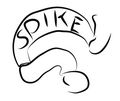The large spatial installation that follows is a recent work. Once again Bismarck explores our frequently oversimplified views of nature and how these can influence past and present discourse about politics. In the middle of the main exhibition space a life-size giraffe faces a smaller version of the eques- trian statue of Otto von Bismarck that stands today in Bremen. The two figures have been broken down into segments rather like push puppets, and the impres- sion that they constitute an intact whole is quickly dispelled. Unlike the children’s toy, where the animals collapse and can be righted with ease, these figures must be arduously reconstructed limb by limb. The work can be interpreted as a comment on the debate about how to deal with memorial statues in the public space. At the same time, the artist has combined his ambivalent family history with a societal approach to the history of thought that draws on powerful stereotypes and begins to instil them in early childhood.
In the adjoining room Bismarck presents a video inspired by BBC nature documentaries. “Geh aus mein Herz!” is the bird’s-eye view of a landscape, set to the music of a hymn – which lends the work its title – sung by members of the artist’s family. Is it the singers’ breathing or the viewers’ gaze that is causing these ripples of movement? What might seem at first to be an extract from a documentary celebrating an “untouched” Swiss landscape with great pathos reveals upon closer scrutiny that the motion has been triggered by downwash from a helicopter. The scenery perceived and recorded as tranquil and picturesque is actually the effect of destructive human behaviour. This hypnotic work vividly demon- strates the dangerous consequences of human activity and the boundaries of individual perspective.
In the last section of this show, Bismarck illustrates how the media influence our perception of landscapes. The works on display were co-authored in a variety of constellations with Julian Charrière and Felix Kiessling. All three artists studied under Olafur Eliasson at the Institute for Spatial Experiments. Placed prominently centre stage is the installation “Joe is dead”, where tumbleweed scrambles along a conveyor belt. This plant spreads by letting the wind blow it along the surface of the ground. Tumbleweeds have become a cinematic topos and are often used to symbolise a desolate place or landscape. Alongside this installation there is another work, “I am Afraid I Must Ask You To Leave” (2018 ), which simulates the detonation of natural monuments in the United States. Bismarck and Charrière had replicas of several striking rock formations built to original scale, then blew them up and leaked the videos. As a result, some people believed that these detonations really were happening in US national parks. The display features not only big, highly aesthetic photographs of the explosions but also screens with TV news coverage of the events and comments on social media. The exhibition ends on this note by asking how meanings are assigned and why some aspects of nature are considered to be more valuable, more beautiful or more worthy of protection than others – and who by.



